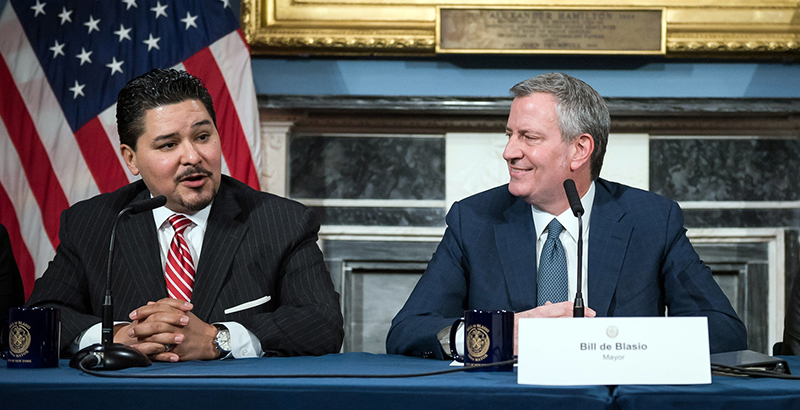What Happens If NYC Eliminates Screened Schools? Amid a Pandemic and Canceled State Tests, Parents Worry About Equity in the District — and Being Locked Out of the Discussion

The first question New York City parents asked as soon as 2019-20 state tests were postponed indefinitely and numeric, final grades were abolished in favor of “meets standards” or “needs improvement” due to the coronavirus crisis was:
How will next year’s fifth- and eighth-graders apply to screened middle and high schools if they will not be able to submit fourth- and seventh-grade test scores and GPAs?
The answer they got from Mayor Bill de Blasio was:
We are just not going to bring New York City back to the status quo that was there before. We’re going to try to create a series of changes that bring equity. … Certainly the screened schools are being re-evaluated.
In NYC, where only a handful of middle and high schools accept students based strictly on their address, students who wish to apply to screened schools must rank up to 12 choices and submit grades and test scores, as well as, sometimes, take additional tests, sit for interviews or produce portfolios of previous work.
Both de Blasio and his schools chancellor, Richard Carranza, are on the record as asserting they believe screened schools are immoral (now that both their daughters have graduated from such schools) and that screens contribute to NYC’s position as America’s most segregated school system.
The popularly accepted narrative goes that the majority of students in screened schools are white, Asian and middle-class in a school system that is mostly Hispanic, black and low-income. This is actually untrue. According to a report by The Center for New York City Affairs, more than half of students in academically screened public high schools are black and Hispanic, some 60 percent of students at those schools are from low-income households, and two-thirds of screened-admission middle schools have student bodies that are majority black and Hispanic. (But why let facts get in the way of some good righteous indignation?)
NYC parents from all ethnic groups are convinced that, by using the pandemic as an excuse to get rid of grades and test scores, de Blasio and Carranza have decided to de facto unscreen those schools — without going through the proper democratic channels. Or seeking input from parents and students.
Various advocacy groups assure the mayor and chancellor that if grades and test scores are taken out of the admissions equation, schools will promptly integrate. Black, Hispanic and poor students will gain access to schools previously dominated by white, middle-class students, and white, middle-class students will gladly attend failing schools where barely 5 percent of students are performing at grade level. This will equalize (or, at least, average out) test scores across the board, making all NYC schools equitable.
Except that, unless de Blasio is proposing taking over admissions and simply plopping children into the schools of his (not their) choice, there is still the matter of families ranking their preferences — and schools ranking their applicants.
Because it’s not only families ranking their top schools. Schools, too, make lists — of prospective students. Then, an algorithm attempts to give everyone their top mutual preference.
This is another thing advocates would like to see less of. The Fordham Law School Feerick Center for Social Justice released a report May 12 titled Public Schools, Public Oversight: Principles and Policy Recommendations During COVID-19 and Beyond that said, among other things, that screening is inherently unequal, noting, “The city should also take the selection process out of schools’ hands by requiring central offices to calculate composite admissions scores for students. In a typical year, many schools are responsible for ranking students for admission.”
They’re right about that. True equality is impossible as long as schools can still rank students — even without grades and test scores.
For instance, unless you get rid of district priority, highly coveted schools like Eleanor Roosevelt will continue taking 100 percent of their students from Manhattan’s District 2, which encompasses the affluent Upper East Side, Tribeca and Chelsea, and completely excluding kids from only a few blocks away in East Harlem. Bedford Academy will continue filling close to 80 percent of its seats with students from District 13 in tony Brooklyn Heights. How many spots will be left for applicants from low-income neighborhoods like Brownsville?
Unless you hide students’ biographical information, do you honestly believe that schools won’t look at the schools students are coming from when ranking for admission? Will a competitive school like Beacon, in District 3 on Manhattan’s Upper West Side, ignore applicants from The Center School, where so many have previously come from, to take a chance on a child from a middle school it has no experience with? Especially with no grades or test scores to look at? Will middle schools pass up students coming from gifted and talented programs to accept kids from elementary schools where only 5 percent of children passed their state exams?
And even if they do, what then? Advocates of a lottery versus a screened admissions system point to Brooklyn’s District 15, where all middle schools were uniformly unscreened, and District 3, where 25 percent of seats in high-performing middle schools were set aside for students with low-scoring 1’s and 2’s on their state tests, as examples of success and a road map for all schools to follow.
They may be demographic successes. But is this truly a success for the students? As one mother railed at a Community Education Council meeting in District 3, “They don’t know what to do with the low-scoring kids who got into these ‘great’ schools, and now they have no support. Do you know how they’re supporting my daughter? They’re not returning my calls. They have no plan!”
Another parent told me, “Our teachers thought they were such great teachers. Until they had to teach kids who didn’t come in already knowing the material, and who couldn’t get help at home or from a tutor.”
So the same number of kids will still be failing. But if they’re distributed across more schools, then at least the failure will be equitable. And easier to hide.
Finally, in order to apply for a high-performing middle or high school, students and their families from low-performing elementary and middle schools have to know those schools exist. How will they know about them? The Department of Education isn’t publishing paper directories anymore! They’re all online!
Wasn’t the key reason for getting rid of grades during the ongoing remote learning period families’ inequality in access to the internet? How are the students who will allegedly be helped the most by unscreening even find out about which schools are suddenly available to them?
You know who will benefit the most from unscreening? Students from well-resourced homes currently earning C’s and B’s at their “good” schools. These are students who, under traditional screening methods, would have had to get in line behind A students, who tended to fill up the top seats.
Without grades, all students will be on an equal academic footing while remaining unequal as to whose families have the knowledge and capability to research all their new options. I’ll be completely transparent: My seventh-grader will be one of those privileged students. Her grades are fine. A’s and B’s. Her test scores are OK. Under normal circumstances, she’d have some shot at the screened schools of her choice. But, under these circumstances, she has as much of a shot as the kids with all A’s and perfect test scores. She also has me. And I know what I’m doing.
Unscreening all NYC schools will benefit the parents who know what they’re doing. And do very little for those already being underserved.
Alina Adams is a New York Times best-selling romance and mystery writer, the author of Getting Into NYC Kindergarten and Getting Into NYC High School, a blogger at New York School Talk and mother of three. She believes you can’t have true school choice until all parents know all their school choices — and how to get them. Visit her website, www.NYCSchoolSecrets.com.
Get stories like these delivered straight to your inbox. Sign up for The 74 Newsletter

;)
